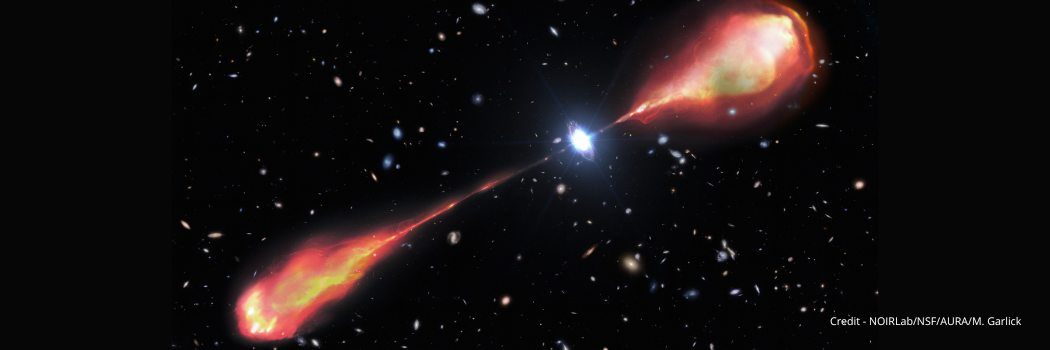
A team of astronomers, including researchers from our top-rated Physics department, have discovered the largest radio jet ever seen in the early Universe.
This discovery sheds new light on how supermassive black holes evolve in the early Universe.
Breakthrough in astronomy
Stretching at least 200,000 light-years (twice the size of the Milky Way) this enormous jet was spotted using the International Low Frequency Array (LOFAR) Telescope.
The radio jet originates from a quasar named J1601+3102, which formed when the Universe was just 1.2 billion years old – less than 10% of its current age.
Quasars are extremely bright galactic cores powered by supermassive black holes that eject vast amounts of energy.
Radio astronomy at Durham
Our expertise in radio astronomy played an important role in this discovery.
The quasar was originally identified by the study's lead author (Anniek Gloudemans; post-doctoral fellow at NSF NOIRLab, Gemini Observatory) using a survey of the sky with Dutch stations of the LOFAR telescope.
Notably, this quasar stood out as the brightest among all those studied, prompting further investigation.
Using all of LOFAR's European antennas, including one station in Chilbolton in the UK, a content-sized telescope was created increasing its ability to see detail 20-fold.
Our researchers were responsible for data reduction, which is the process of converting raw signals from LOFAR's antennas into an image that scientists could analyse.
It is this increase in detail that revealed the enormous radio jet.
"When we started looking at this object we were expecting the southern object to just be an unrelated nearby source, and for the quasar jet to be small. That made it quite surprising when the LOFAR image revealed large, detailed radio structures," said Frits Sweijen, postdoctoral research associate in our Physics department and co-author of the study.
The ability to see that amount of detail in the LOFAR image was vital for confirming the size and structure of the radio jet.
A lot of computational power that was required to efficiently turn the data collected by LOFAR's antennas into an image that scientists can use was provided by our COSMA compute cluster.
Our researchers are instrumental in developing the LOFAR-VLBI pipeline, which will make this kind of science more accessible to users and the scientific community.
At the same time, it provides valuable insights in dealing with the huge data volumes that, for example, the Square Kilometre Array (SKA) project will produce.
A new understanding of black holes
What makes this discovery particularly exciting is that the black hole responsible for the massive jet is not exceptionally large.
This challenges previous assumptions that only the most massive black holes could generate such powerful jets.
The researchers say that this discovery is a major step in understanding how early black holes influence their environments.
J1601+3102's discovery highlights the incredible power of modern radio telescopes and the importance of collaboration between research institutions.
Image - Artist's illustration showing the largest radio jet ever found in the early Universe.






